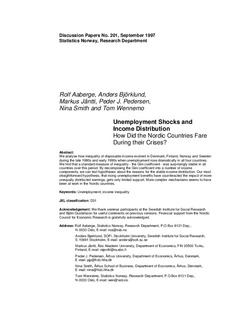| dc.contributor.author | Aaberge, Rolf | |
| dc.contributor.author | Björklund, Anders | |
| dc.contributor.author | Jäntti, Markus | |
| dc.contributor.author | Pedersen, Peder J. | |
| dc.contributor.author | Smith, Nina | |
| dc.contributor.author | Wennemo, Tom | |
| dc.date.accessioned | 2012-01-21T14:11:45Z | |
| dc.date.available | 2012-01-21T14:11:45Z | |
| dc.date.issued | 1997 | |
| dc.identifier.issn | 1892-753x | |
| dc.identifier.uri | http://hdl.handle.net/11250/180745 | |
| dc.description.abstract | We analyse how inequality of disposable income evolved in Denmark, Finland, Norway and Sweden during the late 1980s and early 1990s when unemployment rose dramatically in all four countries. We find that a standard measure of inequality - the Gini coefficient - was surprisingly stable in all countries over this period. By decomposing the Gini coefficient into a number of income components, we can test hypotheses about the reasons for the stable income distribution. Our most straightforward hypothesis, that rising unemployment benefits have counteracted the impact of more unequally distributed earnings, gets only limited support. More complex mechanisms seems to have been at work in the Nordic countries. | no_NO |
| dc.language.iso | eng | no_NO |
| dc.publisher | Statistics Norway, Research Department | no_NO |
| dc.relation.ispartofseries | Discussion Papers;No. 201 | |
| dc.subject | Unemployment | no_NO |
| dc.subject | Arbeidsledighet | no_NO |
| dc.subject | Income inequality | no_NO |
| dc.subject | Inntektsforskjeller | no_NO |
| dc.subject | Income distribution | no_NO |
| dc.subject | Inntektsfordeling | no_NO |
| dc.subject | JEL classification: D31 | no_NO |
| dc.subject | Norway | no_NO |
| dc.subject | Norge | no_NO |
| dc.subject | Denmark | no_NO |
| dc.subject | Finland | no_NO |
| dc.subject | Sweden | no_NO |
| dc.title | Unemployment shocks and income distribution : how did the Nordic countries fare during their crises? | no_NO |
| dc.type | Working paper | no_NO |
| dc.subject.nsi | VDP::Social science: 200::Economics: 210::Economics: 212 | no_NO |
| dc.source.pagenumber | 39 s. | no_NO |
